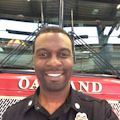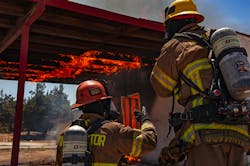Every day, the venerable Merriam-Webster lexicon source posts a different word and its meaning on its website as the “word of the day.” Comparably, men and women report to fire stations all across the world every day ready to serve.
Like Merriam-Webster, the fire service has been around for quite some time. Resulting from the proliferation of the digital platform, Merriam-Webster has migrated away from an exclusive print source to one that serves in both the print and digital formats. The fire service—and the individuals who make up the fire service—has experienced a tectonic transformation, too—one that places a tremendous amount of responsibility on each individual in a number of various disciplines. The word “smart” first was used in the 12th century. In the early part of the 18th century, the word “aggressive” came into existence.
In the fire service today, we promote the word “aggressive” regularly. We use the term when we are interviewed by a reporter (“We engaged in an aggressive fire attack”); we use it to describe our individual company or department (“We are an aggressive fire department”); and we use it to describe members who we admire (“They are aggressive firefighters”).
Rarely do we describe our actions or our individual organization as “smart.” When was the last time that you heard a fire official use the term “smart firefighting” in a media report? When was the last time a training officer substituted the term “aggressive fire attack evolution” with “smart fire attack evolution”? Words and terms are drivers of our behaviors and performances in the hazard zone.
Gravitating toward smart
Why focus on smart training and smart firefighting? It is because we continue to harm fire service personnel in the same known, predictable ways. In a report that was published several years ago by a midwestern news source, the author highlighted the following quotes from firefighters:
- “We allow the same events to occur year after year that lead to firefighter fatalities”
- “He wasn’t supposed to die”
- “Firefighters die over and over from preventable mistakes”
Are our so-called aggressive actions and mindsets what injure and kill us at rates that are still too high in the 21st century?
To my fellow professional fire service colleagues who are sitting at the firehouse coffee table reading this article, substituting the term “aggressive” with “smart” isn’t the sole solution. More importantly, in no form am I advocating the avoidance of searching for humans and applying water from inside of a structure when the situation warrants those activities.
Smart training and smart firefighting derive from the behaviors and actions of humans. Equipment and technology are essential, but the human component is the most important piece.
The company officer
This distinguished position in the fire service requires an individual who values “smartness” in all arenas of the profession—namely his/her professional development and that of the individuals who are assigned to the company. Smart professional development encompasses formal educational opportunities; seminars/classes that are in line with many of the job performance requirements that are outlined in various NFPA standards; and opportunities to enhance essential skills, particularly communications, collaboration/team-building and interpersonal relations.
The COVID-19 pandemic has forced educational institutions, private sector organizations and the public sector to fully embrace a “smarter” medium (learning management systems) to help with cognitive learning. A learning management system is an excellent tool for the adult learner when it is designed correctly, is uploaded with correct and relevant information and incorporates numerous features that are proven methods for satisfying behavior modification.
Where can the company officer direct his/her people for professional development opportunities that will complement growth? Staples include the National Fire Academy; colleges and universities, particularly institutions that cater to professional adults; short courses that are offered through local government entities; and national public administration associations.
Smart professional development leads to a workforce of professional firefighters who are continually exposed to concepts/themes that expand beyond ones that are “fire” specific.
The “why”
What we do in the training environment significantly influences how we behave and perform in the hazard zone (emergency scene). Smart training and education must include the all-important discussion regarding the “why.” This isn’t a generational requirement. It is a human requirement.
When we have a higher than normal comprehension of the why, we increase our likelihood of applying appropriate behaviors and performances in the hazard zone with greater success. Moreover, this essential concept serves as an influencer of firefighter safety in the hazard zone.
Why is a coordinated attack important? Why do we enforce PPE compliance, including SCBAs, at all times while in the immediate dangerous to life and health (IDLH) environment? Why is it important to have a good comprehension of modern fire behavior, building construction, engine company operations and truck company operations? In many instances, we are good at the performance of several essential fireground task-level activities as a whole, but we fail our people and our organizations when we can’t articulate the “why” that’s behind these essential tasks.
Company officers and training officers: Begin and end with the “why.”
The right “mix”
Each of us is responsible for our own training and education; however, ultimately, it is the responsibility of the company officer to ensure that his/her subordinates engage in the learning process that’s a requirement in our profession. Smart training and education are a central link to company and department success. Use your response district to guide the right combination of training and education that should be part of your day on the “job.”
If you work at a downtown station, include high-rise operations in your training and educational experiences. If you work in an area that has a mix of wildland and urban interface, include wildland operations in your training and educational experiences. If you work in an area that has a large mix of mid-rises and apartment buildings, include hose-stretching evolutions in your routine training experiences.
The right mix of training and education sets your people up for success by allowing them to engage in smart practices at real emergencies.
What results
When we engage in smart principles that fall under training and education, we still can satisfy our responsibilities as firefighters. Our fire attack operations, search and “truck work” still can rival that of being aggressive. The key is that we simply are being smart about our behaviors and performances in the hazard zone. We move away from the “we have always done it this way” or “this is what the citizens expect from us.” As a private citizen, I never received a survey from my local fire department that asked me what I want them to do if they come to my home for an emergency or to what degree they should risk their own personal safety for the sake of others. If I ever receive such a survey, I simply will reply, “Use your training and education to engage in smart firefighting task-level activities to save my family and me. Also, avoid aggressiveness that is akin to recklessness at all costs.”
The “word of the day” every day that we are on duty should be all about smart firefighting.
About the Author

Demond Simmons
Demond Simmons is a 23-year member of the Oakland, CA, Fire Department. He is on detail as the special operations battalion chief. Simmons serves on the board of the International Association of Fire Chiefs (Company Officers Section) and is an adjunct instructor at the National Fire Academy. He teaches at numerous colleges and universities. Simmons has a doctorate in business administration.
